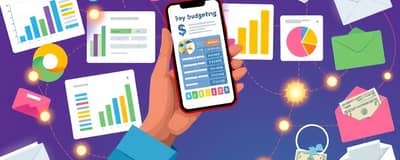How to Use Online Budgeting Tools for Better Savings

In an era where every penny counts, mastering online budgeting tools can transform your financial journey. From automating mundane tasks to uncovering hidden savings opportunities, these platforms empower you to take control of your money and build lasting wealth.
Why Online Budgeting Tools Matter
Traditional budgeting methods often involve manual spreadsheets or paper ledgers, both of which can become overwhelming and error-prone. In contrast, online solutions centralize data and provide real-time financial insights at a glance. By syncing bank accounts, credit cards, loans, and investments into one dashboard, you gain a complete snapshot of your cash flow and net worth without the legwork.
These digital tools are designed to automate and simplify the process of tracking expenses, categorizing spending, and setting savings targets. They serve as a personal financial coach, nudging you toward smarter decisions, alerting you to potential overspending, and ensuring you stay aligned with your long-term objectives.
Key Benefits and Features
- Automation of expense tracking and categorization saves hours each month.
- Customizable savings and debt payoff goals keep you motivated.
- Intuitive dashboards and charts highlight trends and anomalies.
- Alerts for upcoming bills and budget limits prevent late fees.
- Mobile access lets you check balances on the go.
By reinforcing accountability and providing visual feedback, these platforms help you build healthier money management habits, reduce financial stress, and accelerate progress toward your dreams.
Top Online Budgeting Tools for 2025
The selection of a budgeting app depends on your specific needs—whether personal or business. Here are some leading options:
For individuals:
- Mint: A free, user-friendly app offering automated tracking, categorization, and goal setting.
- You Need a Budget (YNAB): Employs the envelope method to plan every dollar, subscription-based for serious planners.
- Quicken Simplifi: A paid solution with advanced analytics, customizable reports, and credit score monitoring.
For businesses:
- QuickBooks: Comprehensive expense management, payroll integration, automated financial reports, and AI-driven recommendations and credit monitoring.
- Scoro: All-in-one software combining CRM, project management, KPI tracking, and forecasting.
Spreadsheets like Google Sheets and Microsoft Excel remain popular among users seeking full customization, though they lack automatic syncing and reporting features.
Comparing Essential Features
Getting Started: Setup and Customization
Initiating your journey is straightforward. Follow these foundational steps to ensure a strong start:
- Link all financial accounts to gain a centralized view of your finances.
- Customize spending categories to reflect personal habits or business operations.
- Establish clear savings or debt-removal targets using in-app goal features.
- Set up alerts for due dates and budget thresholds to stay proactive.
Periodic reviews—weekly or monthly—will help you catch overspending early and keep your plan relevant as your life evolves.
Optimizing Your Savings Strategy
Once your tool is live, optimization becomes the key to unlocking further financial gains. Utilize built-in reports to analyze past spending patterns. Identify categories where you consistently overshoot and reallocate those funds toward high-priority goals.
Automation can be your ally: schedule recurring transfers for savings accounts or retirement funds. This “set and forget” approach ensures consistency without emotional friction, allowing you to align daily behavior with long-term goals effortlessly.
Avoiding Common Pitfalls
No system is foolproof. Be mindful of these potential drawbacks:
- Security Risks: Research data protection measures and choose platforms with robust encryption.
- Subscription Fees: Weigh the cost-benefit ratio of premium features before committing.
- Sync Errors: Occasionally reconcile accounts manually to correct miscategorized or missing transactions.
- Overreliance: Regularly engage with reports to understand your finances deeply, rather than outsourcing all decision-making.
Balancing automation with hands-on review ensures you remain the architect of your own financial destiny.
Advanced Tips and Emerging Trends
Looking ahead, budgeting tools are integrating more sophisticated capabilities. Voice commands, AI-driven spending forecasts, credit score monitoring, and integration with payroll or CRM systems are becoming standard. Embrace these innovations to stay ahead of the curve.
Consider experimenting with pairing your budgeting app with complementary platforms—investment trackers, debt payoff calculators, or tax-optimization services—to create a holistic financial ecosystem that serves every facet of your life.
Conclusion: Take Control of Your Financial Future
Online budgeting tools are more than just digital ledgers; they’re catalysts for behavioral change and financial empowerment. By leveraging automation, real-time data, and targeted insights, you can overcome spending pitfalls, reach savings milestones, and ultimately secure the future you envision.
Whether you’re planning for a dream vacation, paying off debt, or scaling a business, these platforms provide the structure, guidance, and flexibility you need. Start today, stay consistent, and watch your financial confidence—and your savings—grow stronger every day.
References
- https://www.businessinsider.com/personal-finance/banking/best-budgeting-apps
- https://www.uschamber.com/co/run/technology/budgeting-features-and-tools
- https://www.oneazcu.com/about/financial-resources/saving-budgeting/the-pros-and-cons-of-budgeting-apps/
- https://www.equifax.com/personal/education/personal-finance/articles/-/learn/budgeting-apps/
- https://quickbooks.intuit.com/au/blog/running-a-business/budgeting-software/
- https://www.purdueglobal.edu/blog/student-life/budgeting-apps-personal-finance-tools/
- https://www.consumerreports.org/money/personal-finance/benefits-and-risks-of-using-personal-financial-apps-websites-a8590361886/
- https://design.canada.ca/style-guide/






